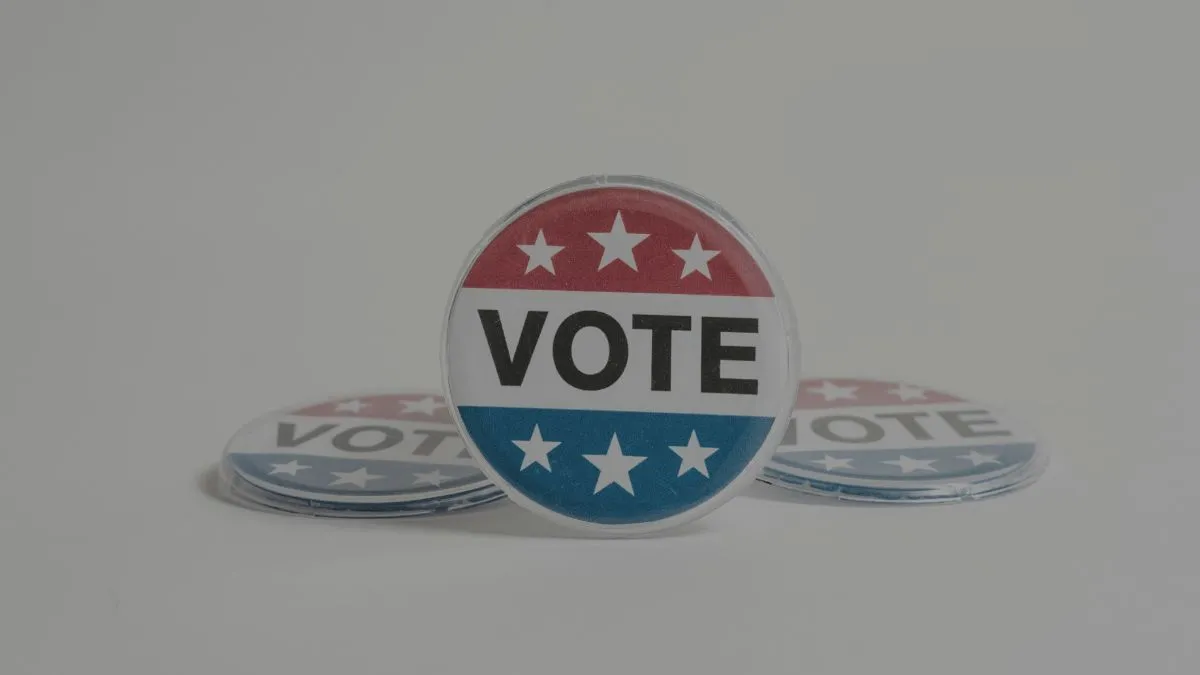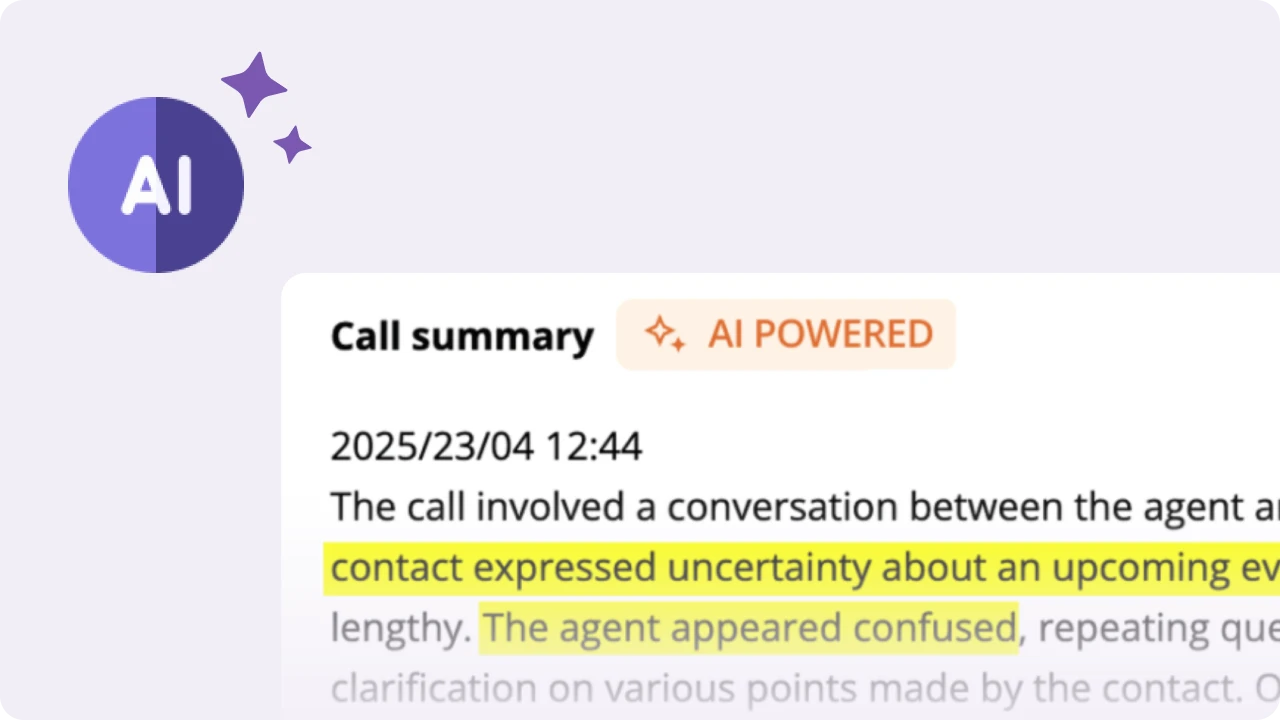Table of Contents
Voter engagement with text messaging is at an all-time high. In the 2022 election cycle alone, Americans received over 15 billion political texts, amounting to nearly 50 messages per phone nationwide.
This surge marks a 158% increase from 2021, while political calls dropped by 57% to 384 million. Whether a nudge to get out the vote (GOTV), a quick donation link, or a reminder about registration deadlines, SMS has become one of the go-to tools for political campaigns.
By outlining the reasons behind the explosive growth and effectiveness of SMS in voter engagement, this article aims to equip campaigners and advocacy groups with the insight and strategies needed to harness the full potential of text messaging for voter engagement at every level of the political cycle.
Let’s explore below why text messaging has become a non-negotiable for modern campaigns.
Voter engagement with text messaging: Why use it?

From introducing a candidate or policy to converting interest into volunteer sign-ups or ballot casts, text messages provide a seamless, low-friction pathway for voter progression.
And it’s more than that – it’s an influence:
- 45% of voters respond to campaign texts, compared to just 6% for email.
- 31% of Americans say political texts influenced how they voted.
- SMS reminders have been proven to increase turnout by 8-9%, especially among young or first-time voters.
- Campaigns that use segmentation and A/B testing in texts have seen higher engagement rates and turnout lift in targeted groups.
Read more: The power of voter engagement: key strategies for success.
These influences aren’t just theoretical; they play out in real time throughout every stage of the electoral process, which is why all campaigns must make full use of SMS at every stage.
Now that you know the why, let’s quickly take a look at the ‘when’ – which is how often and at what times you need to send out SMS campaigns.
Voter engagement with text messaging in the election cycle.
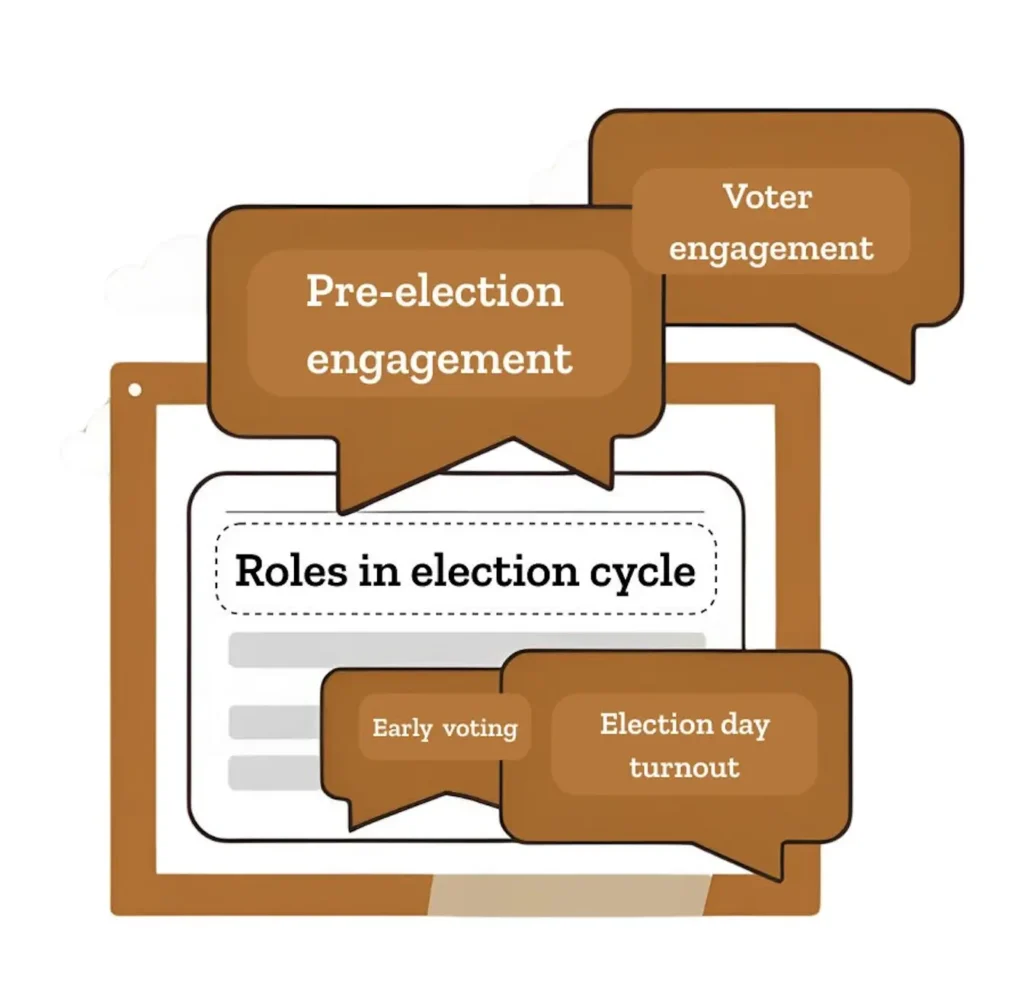
Text messaging isn’t just a one-day tactic – it’s a tool you can use at every stage of your campaign.
Imagine this: A local candidate, Maya, started her outreach campaign months before election day. She texted reminders about the registration deadlines, sent early voting information, shared polling locations the night before, and even followed up with thank-you messages after the polls closed. This led to supporters feeling connected and informed in every step of the campaign.
Here’s how you can use SMS to engage voters from start to finish:
1. Voter registration drives

Voter engagement with text messaging begins early, with campaigns sending targeted SMS reminders to encourage registration. Text-based registration campaigns have been shown to boost registration rates by up to 8%, especially among the younger demographics.
PS: With CallHub, you can personalize every text message using merge tags and custom fields, making outreach feel directly relevant.
You can also opt for CallHub’s MMS feature to send images or videos explaining how to register and make your campaign stand out.
2. Engagement during pre-election campaigning
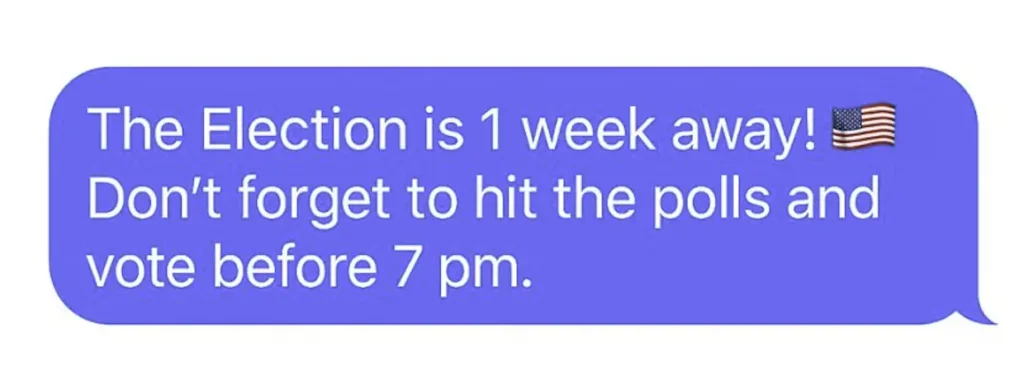
With weeks and days leading up to the Election Day, voter engagement with text messaging keeps supporters updated on candidates, policies, and voting logistics.
Campaigns can also use surveys and polls via peer-to-peer texting to gather voter feedback and tailor their messaging as voting day approaches.
In contrast, regular mass text blasts ensure essential information reaches every supporter immediately.
So mix and match your methods. Remember that SMS lets you keep in close touch with your voters, helping you tweak your strategy as needed.
3. Boosting early voting participation.
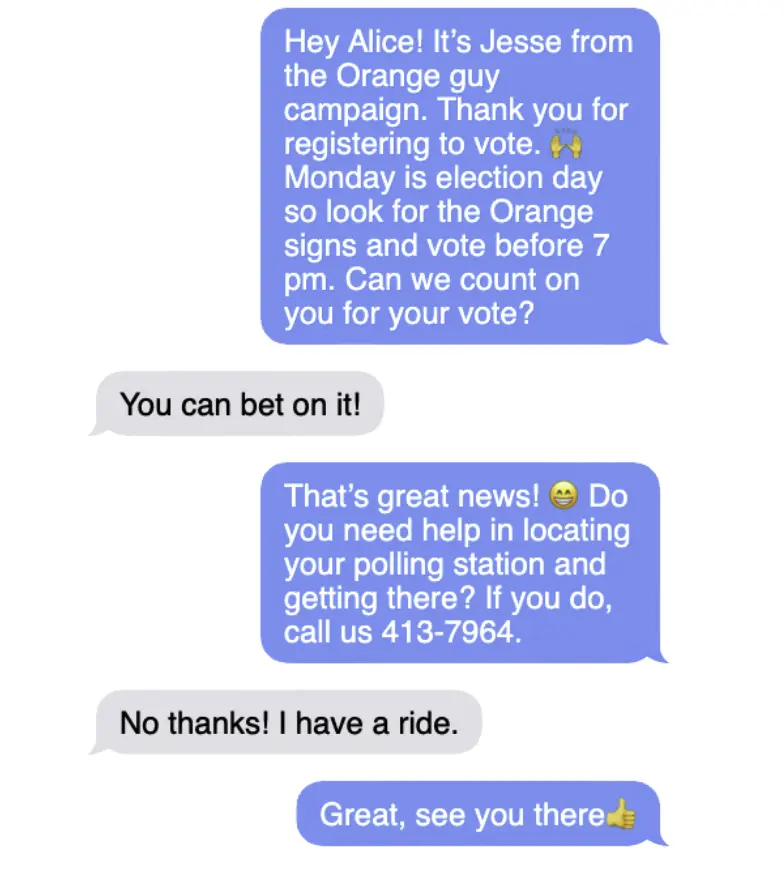
Timely SMS reminders have been shown to increase early voting turnout by 8-9%.
So, ensure your supporters cast their ballots ahead of time with CallHub. Campaigns can schedule and automate early voting prompts, providing voters personalized information about locations and deadlines.
The mass broadcasts can be as simple as “Hey! The voting booth is at XYZ location in your neighborhood”. Studies show the reminder itself is enough if it reaches voters in time.
For specific questions on early voting, addressing accessibility concerns, and personal encouragement to vote early, make full use of peer-to-peer texting.
Read more: Peer-to-peer texting complete 2025 guide.
4. Maximizing election day turnout

On election day, voter engagement with text messaging is at its highest. Campaigns often use SMS to recruit last-minute volunteers, send breaking news about endorsements, or quickly counter misinformation until the polls close.
Use CallHub’s SMS solutions for last-minute GOTV and real-time polling location details. Campaigns can also use text-to-donate tools to mobilize last-minute fundraising and mass texting to provide urgent updates or combat misinformation.
Read more: Political text messaging: everything you need to know!
All right, we have now looked at all the times campaigns should use SMS to reach out to voters. But of course, simply sending messages isn’t enough.
To truly harness the power of SMS, campaigns must use smart strategies to personalize, automate, and optimize their outreach. Here’s how you can make every text count.
Strategies to drive voter engagement with text messaging
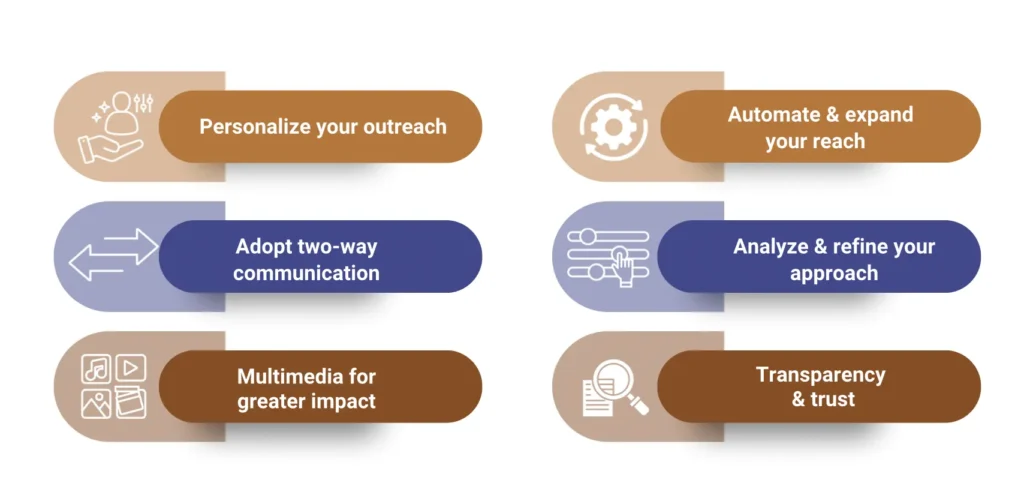
Effectively engaging voters through text messaging requires more than just sending bulk messages – using smart, targeted techniques. This section will explore the proven strategies to optimize your SMS outreach.
Personalize your outreach
An effective voter engagement starts with understanding your audience. Instead of sending generic messages to everyone, segment your contact lists based on location, voting history, age, or interests.
Personalize each message with the recipient’s name and local topics, increasing the likelihood of a positive response.
Don’t let your outreach be limited by language or visuals. Using CallHub, you can also send SMS in the voter’s preferred language.
Adopt two-way communication whenever possible.
Instead of sending out messages and hoping for the best, encourage people to reply – whether they have questions, want to share their opinions, or simply want to say they’re planning to vote.
With peer-to-peer texting tools, your team can answer voter questions on the spot and have a two-way conversation with them on any concern.
Use multimedia for greater impact.
Don’t just send plain texts. Make your messages more eye-catching and easily understood by adding images, videos, or infographics through MMS.
For example, send a quick video explaining how to vote or a graphic showing polling locations. Visual content is especially effective for younger voters or anyone who prefers seeing information rather than just reading it. And MMS can even deliver sample ballots or explainers, making elections more accessible.
So use MMS wherever possible.
Automate and expand your reach
Reaching a large audience efficiently means using CallHub’s automation tools to schedule and deliver messages at the right time.
You can remind people about registration deadlines, early voting, or election day itself through automation. By automating a routine message, your team can focus on more personal interactions and make sure no updates are missed.
Analyze and refine your approach.
To make your SMS campaigns more effective, monitor the key metrics such as how many messages were delivered, opened, and responded to.
Try out different versions of your messages, send times, and calls to action to see what works best. Regularly reviewing these results and making adjustments will help you improve engagement.
Uphold transparency and trust.
In a world of information, honesty matters. Always make it clear who is sending the message, respect requests to opt out, and follow all relevant laws and guidelines. Let people know how you got their contact details and what you’ll use them for. Being upfront and ethical helps build lasting trust with your audience.
All right, it is easy to list the strategies, but how good is it in practice?
Here is a real-world example of applying these techniques and making a measurable difference.
Case Study: Kentucky voter engagement with text messaging

|
The Kentucky Democratic Party leveraged CallHub for voter engagement during the 2022 General Election.
Key Features used:
Benefits experienced:
Impact:
|
The road forward
Now that you’ve seen how text messaging can boost voter engagement at every election stage, it’s time to implement these strategies. With CallHub, you can easily personalize, automate, and scale your outreach, ensuring your message reaches and motivates more voters.
Ready to make a real impact? Start your next campaign with CallHub and experience the difference effective text messaging can make. Start today!
